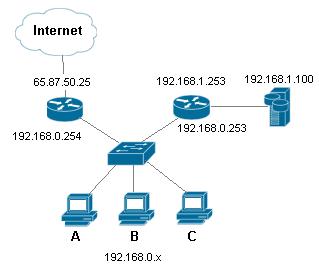we have two router in our office lan,one for accessing internet and other one for accessing our own office sites
(intranet).Is it possible that we can access both internet and our own office sites by adding double default gateways. Internet(default gateway 10.133.14.1) and own local sites default gateway (10.133.14.10).how can we access both simultaneously
singhneeraj421 0 Newbie Poster
Recommended Answers
Jump to PostIt would be easier to redesign your network layout, but to answer your question, you would have to add static routes in the local routing tables for all of the computers on the 10.133.14.x subnet so they know which gateway to use to get to the correct remote subnet.
Jump to PostMy 2 cents:
You can't have more than 1 gateway. You should opt to use the gateway that will be used for the 'catch-all', this is usually the one that leads to the public internet. On that gateway, you should add in static routes for other internal subnets and the …
Jump to PostIt would be easier to redesign your network layout
Just to clarify my earlier post.... I'm not suggesting that you maintain this design. It can be technically done with two gateways...you can have as many gateways as you desire on a subnet although a subnet with multiple gateways …
All 12 Replies
JorgeM 958 Problem Solver Team Colleague Featured Poster
CimmerianX 197 Junior Poster
JorgeM 958 Problem Solver Team Colleague Featured Poster
singhneeraj421 0 Newbie Poster
CimmerianX 197 Junior Poster
JorgeM 958 Problem Solver Team Colleague Featured Poster
singhneeraj421 0 Newbie Poster
JorgeM 958 Problem Solver Team Colleague Featured Poster
CimmerianX 197 Junior Poster
singhneeraj421 0 Newbie Poster
JorgeM 958 Problem Solver Team Colleague Featured Poster
singhneeraj421 0 Newbie Poster
Be a part of the DaniWeb community
We're a friendly, industry-focused community of developers, IT pros, digital marketers, and technology enthusiasts meeting, networking, learning, and sharing knowledge.

